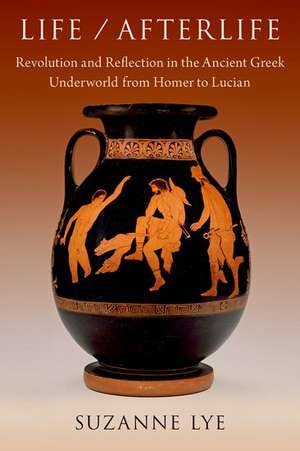Life / Afterlife: Revolution and Reflection in the Ancient Greek Underworld from Homer to Lucian
Autor Suzanne Lyeen Limba Engleză Hardback – 20 dec 2024
Preț: 373.39 lei
Preț vechi: 512.17 lei
-27% Nou
Puncte Express: 560
Preț estimativ în valută:
71.45€ • 74.80$ • 59.12£
71.45€ • 74.80$ • 59.12£
Carte disponibilă
Livrare economică 05-11 martie
Preluare comenzi: 021 569.72.76
Specificații
ISBN-13: 9780197690208
ISBN-10: 0197690203
Pagini: 336
Dimensiuni: 165 x 249 x 31 mm
Greutate: 0.64 kg
Editura: Oxford University Press
Colecția OUP USA
Locul publicării:New York, United States
ISBN-10: 0197690203
Pagini: 336
Dimensiuni: 165 x 249 x 31 mm
Greutate: 0.64 kg
Editura: Oxford University Press
Colecția OUP USA
Locul publicării:New York, United States
Recenzii
Lye's hypertextual approach provides rich insights into Underworld scenes in Greek literature, deftly combining innovative theoretical methodology with careful close readings of particular scenes. She shows how authors create meaning in conjunction with their readers by crafting their accounts to enable links with the traditional elements of Underworld scenes, making a nexus with other tellings familiar to their audiences. Specialists and students alike will benefit from this excellent study.
This is an ambitious study that discusses the Underworld as a theme across different times, genres, and media. It successfully challenges earlier readings that only focus on specific scenes and invites a comprehensive reading of the Underworld scenes in their evolving and interconnected presence in the ancient Greek tradition. It makes us look at texts and visual scenes in 'partnership' with the audiences and viewers who shaped them, tracing the Underworld landscape as a productive imaginary to think with.
Mortal life, as Homeric epic would have us understand, derives its meaning from its limits. It has value because it cannot be replaced. The way we imagine existence after death can be fundamental in helping us appreciate this. And Suzanne Lye has provided us with an irreplaceable guide for thinking through how ancient authors and audiences did this, as well as a template for following her in a similar vein.
This is an ambitious study that discusses the Underworld as a theme across different times, genres, and media. It successfully challenges earlier readings that only focus on specific scenes and invites a comprehensive reading of the Underworld scenes in their evolving and interconnected presence in the ancient Greek tradition. It makes us look at texts and visual scenes in 'partnership' with the audiences and viewers who shaped them, tracing the Underworld landscape as a productive imaginary to think with.
Mortal life, as Homeric epic would have us understand, derives its meaning from its limits. It has value because it cannot be replaced. The way we imagine existence after death can be fundamental in helping us appreciate this. And Suzanne Lye has provided us with an irreplaceable guide for thinking through how ancient authors and audiences did this, as well as a template for following her in a similar vein.
Notă biografică
Suzanne Lye is Assistant Professor of Classics at the University of North Carolina at Chapel Hill.
